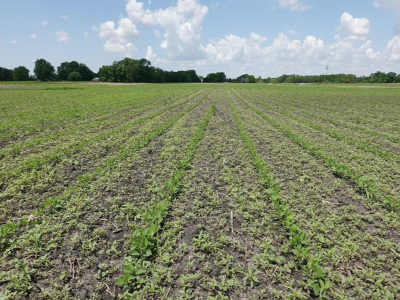By Dr. Bob Hartzler
The potential for continued dry weather across the state raises concerns about the impact of dry soils on preemergence herbicides. Preemergence herbicides kill weeds by being absorbed into the seed as the seed imbibes water. To be effective, the herbicide must be located within the soil profile at the depth where weed seeds germinate (primarily the upper inch of soil). In addition, there must be sufficient water to keep the herbicide dissolved in soil water. Both factors can be adversely affected by limited rain early in the season.

Preemergence herbicides need rain to be effective.
Most farmers rely on rain to move the herbicide into the soil profile. It typically takes at least a half-inch of rain to activate the herbicide, meaning, moving it to the depth where germinating seeds are located. If the upper inch or two of soil is dry, the quantity of rain for activation will be slightly higher since the soil first must be wetted before water will move the herbicide into the profile. Chemical properties of the herbicide, primarily the affinity of the herbicide for soil colloids, affect how much rain is required for activation. Research at the University of Illinois showed relatively small differences in the rainfall requirement between two Group 15 herbicides (Table 1). Acetochlor binds less tightly to soil colloids than S-metolachlor, and thus would be expected to require less rain for activation. There was a difference in performance with a quarter-inch rain, but neither product provided acceptable control with this limited amount of rain.

Delays between herbicide application and the first activating rainfall is a common cause of residual herbicide failures. A rule of thumb is that an activating rain is needed within five to seven days of application, but as with any biological response, many factors influence this time interval.
- Early spring applications (early April) can ‘wait’ longer for activating rain than late-April applications since most weeds haven’t begun to germinate at the time of early spring-applications.
- Tillage ‘resets’ weeds by killing emerged weeds and disrupting seeds that have initiated germination. Delays between the final tillage pass and residual herbicide application will shorten the time between application and when an activating rain is needed for good results.
Even if a herbicide is activated in a timely fashion, performance may be reduced when there is limited rain in the weeks following application and activation. As soil dries, preemergence herbicides move from the soil water to adsorption sites on soil colloids, therefore reducing the amount of herbicide available to germinating weed seeds. Herbicides less tightly bound to soil colloids may provide more consistent control during dry years. Group 3 herbicides (trifluralin, pendimethalin) require more soil moisture than other preemergence herbicides due to their high affinity for soils, whereas differences among other products are relatively small.
Timing of activating rain and soil moisture are important factors influencing residual herbicide activity, but our inability to accurately predict when specific fields will receive rain limits our ability to manage herbicides to account for this variable. However, important things to consider for this year include:
- Last year’s dry weather should not impact this year’s herbicide performance, but if the surface soil is dry at the time of residual herbicide application it will require more rain to activate herbicides than if soils are moist.
- Early preplant applications reduce the need for timely rainfall, but consider the impact of early application on the length of residual activity and the effect of seedbed preparation tillage on herbicide distribution.
- Using full rates can reduce some of the variability brought on by limited rain and soil moisture.
- If a field fails to receive an activating rain within 5-7 days of application, consider using a rotary hoe or harrow to control weeds escaping the residual herbicide. These tools are most effective before germinating weeds emerge (white root stage). If this isn’t possible, begin to scout fields within two weeks of planting to determine the appropriate time for postemergence applications.
Even with dry conditions, residual herbicides are valuable and important for weed management. While scouting is always important to determine the most appropriate timing for herbicide applications, it will be even more important if rainfall continues to be limited this season.
Source : iastate.edu